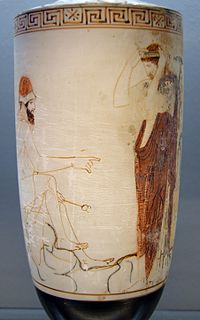
Back Hades ALS العالم السفلي اليوناني Arabic গ্রিক পাতাল Bengali/Bangla Ifernioù Breton Had (podzemni svijet) BS Inframon grec Catalan Řecké podsvětí Czech Hades (isfyd) Welsh Unterwelt der griechischen Mythologie German Inframundo griego Spanish

| Part of a series on the |
| Greek underworld |
|---|
| Residents |
| Geography |
| Prisoners |
| Visitors |
In Greek mythology, the Greek underworld, or Hades, is a distinct realm (one of the three realms that make up the cosmos) where an individual goes after death. The earliest idea of afterlife in Greek myth is that, at the moment of death, an individual's essence (psyche) is separated from the corpse and transported to the underworld.[1] In early mythology (e.g., Homer's Iliad and Odyssey) the dead were indiscriminately grouped together and led a shadowy post-existence; however, in later mythology (e.g., Platonic philosophy) elements of post-mortem judgment began to emerge with good and bad people being separated (both spatially and with regards to treatment).[2]
The underworld itself— commonly referred to as Hades, after its patron god, but also known by various metonyms—is described as being located at the periphery of the earth, either associated with the outer limits of the ocean (i.e., Oceanus, again also a god) or beneath the earth.[3][4] Darkness and a lack of sunlight are common features associated with the underworld[5][6] and, in this way, provide a direct contrast to both the 'normality' of the land of the living (where the sun shines) and also with the brightness associated with Mount Olympus (the realm of the gods).[7][8] The underworld is also considered to be an invisible realm,[9] which is understood both in relation to the permanent state of darkness but also a potential etymological link with Hades as the 'unseen place'.[10] The underworld is made solely for the dead and so mortals do not enter it – with only a few heroic exceptions (who undertook a mythical catabasis: Heracles, Theseus, Orpheus, possibly also Odysseus, and in later Roman depictions Aeneas).[11]
- ^ Homer's Iliad & Odyssey
- ^ Garland, Robert (2001). The Greek way of death (2nd ed.). Ithaca, NY: Cornell Univ. Press. pp. 60–61. ISBN 978-0-8014-8746-0.
- ^ Garland, Robert (2001). The Greek Way of Death (2nd ed.). Ithaca, NY: Cornell Univ. Press. p. 49.
- ^ For use of the metonymic description "the world below" (hupenerthe), see Hom. Il. 3.278, 20.61; for the formulaic statement "beneath the depths of the earth" see Hom. Od. 24.204; Il. 22.482-83.
- ^ Long, J. Bruce (1989). "The Underworld". In Sullivan, L (ed.). Death, Afterlife, and the Soul. New York, NY: MacMillan. p. 164.
- ^ Cousin, C (2012). Le monde des morts: Espaces et paysages de l'au-delà dans l'imaginaire grec d'Homère à la fin du Ve siècle avant J.-C: étude littéraire et iconographique (in French). Paris: L'Harmattan. pp. 124–134.
- ^ Sourvinou-Inwood, Christiane (1995). 'Reading Greek death': To the end of the Classical Period. Oxford, UK: Clarendon Press. p. 72.
- ^ Homer Odyssey 6.44-45.
- ^ Gazis, George (2018). Homer and the Poetics of Hades. Oxford, UK: Oxford Univ. Press. pp. 13–15.
- ^ Cousin, C (2012). Le monde des morts: Espaces et paysages de l'au-delà dans l'imaginaire grec d'Homère à la fin du Ve siècle avant J.-C: étude littéraire et iconographique (in French). Paris: L'Harmattan. p. 125.
- ^ There is still no scholarly consensus on whether Odysseus' nekuia (Od. 12) is to be understood as either a necromantic act that took place on the borders of the underworld, or a catabatic act that involved him entering the underworld proper.
© MMXXIII Rich X Search. We shall prevail. All rights reserved. Rich X Search